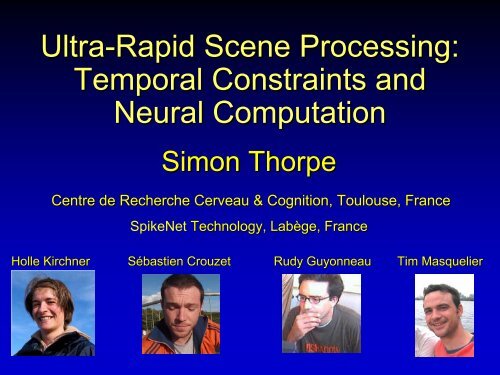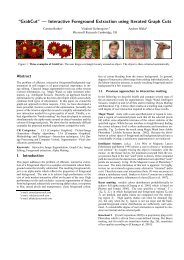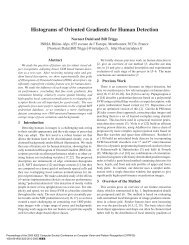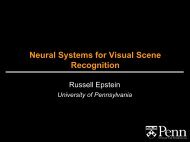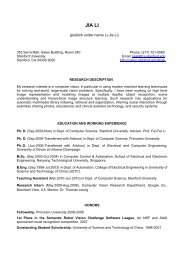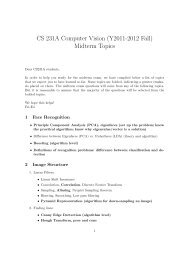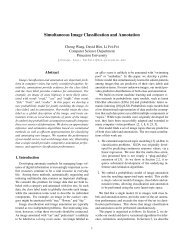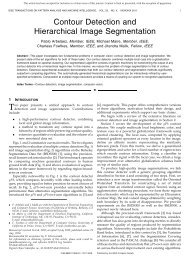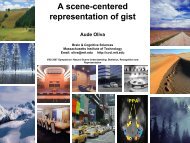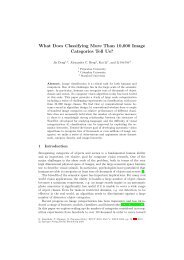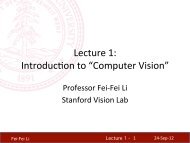Ultra-Rapid Scene Processing - Stanford Vision Lab
Ultra-Rapid Scene Processing - Stanford Vision Lab
Ultra-Rapid Scene Processing - Stanford Vision Lab
You also want an ePaper? Increase the reach of your titles
YUMPU automatically turns print PDFs into web optimized ePapers that Google loves.
<strong>Ultra</strong>-<strong>Rapid</strong> <strong>Scene</strong> <strong>Processing</strong>:<br />
Temporal Constraints and<br />
Neural Computation<br />
Simon Thorpe<br />
Centre de Recherche Cerveau & Cognition, Toulouse, France<br />
SpikeNet Technology, <strong>Lab</strong>ège<br />
ge, , France<br />
Holle Kirchner<br />
Sébastien<br />
Crouzet<br />
Rudy Guyonneau<br />
Tim Masquelier
Plan<br />
<strong>Ultra</strong> <strong>Rapid</strong> <strong>Processing</strong> of Natural Images<br />
• Certain key stimuli such as animals and faces can<br />
be detected in complex natural scenes in as little<br />
as 100 ms<br />
Biological plausible processing algorithms<br />
• Feed-forward models<br />
• Computation with a wave of spikes<br />
• Rank order coding<br />
• Spike Time Dependant Plasticity<br />
A mechanism for unsupervised learning of<br />
frequently occuring visual patterns
<strong>Ultra</strong> <strong>Rapid</strong> <strong>Scene</strong> <strong>Processing</strong><br />
Behavioural Reaction Times<br />
Event Related Potentials<br />
Difference<br />
Targets<br />
<strong>Scene</strong> <strong>Processing</strong> in 150 ms<br />
Distractors
<strong>Rapid</strong> Animal Categorisation Tasks<br />
Manual Saccadic Go/Nogo choice Choice<br />
with Presentation 20 ms Flash<br />
400 ms<br />
+ +<br />
400 ms<br />
Mean RT = 180 ms<br />
+<br />
+<br />
+<br />
20 ms<br />
800-1600 200 ms<br />
ms<br />
800-1600 ms<br />
800-1600 ms<br />
200 ms<br />
20 ms<br />
14%<br />
12%<br />
10%<br />
8%<br />
Mean RT = 228 ms<br />
(Kirchner & Thorpe, VR, 2006)<br />
Mean RT<br />
~ 400 ms<br />
6%<br />
4%<br />
Correct<br />
Errors<br />
2%<br />
0%<br />
0 100 200 300 400 500<br />
Reaction Time (ms)
<strong>Ultra</strong>-<strong>Rapid</strong> Detection of Human Faces<br />
400 ms<br />
200 ms<br />
+<br />
800-1600 ms
Results for 8 subjects<br />
45<br />
40<br />
35<br />
30<br />
Correct<br />
Errors<br />
Number<br />
25<br />
20<br />
15<br />
Minimum RT<br />
Around 100 ms<br />
Accuracy = 89.3%<br />
Mean RT = 140.7 ms<br />
10<br />
5<br />
0<br />
0 50 100 150 200 250<br />
Reaction Time (ms)
Fast trials for one subject<br />
109<br />
122<br />
• All trials with RTs of ≤ 122 ms<br />
• Correct on 22/24 (91.6%)
What Pathways are Involved?
A temporal saliency effect?<br />
Primate Faces<br />
Non-Primate<br />
Faces
What could be the mechanism?<br />
Decision Level Response Motor System<br />
High Level<br />
Feature<br />
Combinations<br />
IT?<br />
Intermediate<br />
Level Features<br />
V4<br />
Preprocessing<br />
Input Level<br />
V1/V2<br />
Feedforward architectures are enough,<br />
But......
The Temporal Coding Option<br />
Two Key Ideas<br />
• Coding with a wave of spikes<br />
• The most strongly activated neurons fire first<br />
• Spike Time Dependent Plasticity<br />
• With repeated exposure, high weights will<br />
concentrate on the inputs that fire first<br />
Song, Miller & Abbott, 2000
Rank Based Coding<br />
1% of the population active is enough for recognition !<br />
(VanRullen<br />
& Thorpe, 2001)
Rank Based coding with STDP
STDP Based Learning<br />
With Rank-based<br />
coding and STDP,<br />
neurones naturally<br />
(a) become selective<br />
to repeatedly<br />
presented stimuli<br />
(b) respond more<br />
and more quickly
STDP with a population of output cells<br />
Synapse<br />
s<br />
K-WTA<br />
circuit<br />
Neurons compete to grab parts of feature space
Second layer training<br />
STDP Learning with Natural Images<br />
First layer training
Learning Objects
<strong>Scene</strong> <strong>Processing</strong> Conclusions 1<br />
Temporal constraints have got even worse!<br />
• Key visual patterns such as faces can be detected in roughly 100 ms<br />
Strong evidence for very rapid feedforward mechanisms<br />
• Serre, Oliva & Poggio (2007)<br />
<strong>Processing</strong> using Spikes<br />
• The most strongly activated neurons fire first<br />
• Any flashed image will generate a wave of spikes<br />
• STDP will systematically concentrate high synaptic weights on the<br />
earliest firing inputs<br />
An unsupervised mechanism that guarantees short latency and<br />
reliable responses to frequently occuring input patterns
<strong>Scene</strong> <strong>Processing</strong> Conclusions 2<br />
Any natural image is likely to contain at least some visual<br />
patterns that can be detected with a feedforward pass<br />
<strong>Processing</strong> time varies depending on the visual pattern<br />
• Fastest for faces (100 ms)<br />
• Fast for animals (120 ms)<br />
• Somewhat slower for other stimuli (140-180 180 ms)<br />
The fastest processing will occur for the most important<br />
frequently occuring visual patterns<br />
The feedforward pass can then be used to guide feedback<br />
mechanisms for other important operations<br />
• Figure-ground<br />
ground segregation<br />
• Accurate localisation
Thanks!<br />
Holle Kirchner<br />
Sébastien<br />
Crouzet<br />
Rudy Guyonneau<br />
Tim Masquelier
Unsupervised learning<br />
Faces<br />
Motorcyles
Developping Face Selective Cells
20%<br />
Transport versus Human<br />
Inversion?<br />
15%<br />
Transport Correct<br />
Accuracy = 89.3%<br />
Mean RT = 140.7 ms<br />
10%<br />
5%<br />
c<br />
Transport Error<br />
Accuracy = 69.0%<br />
Mean RT = 169 ms<br />
0%<br />
0 50 100 150 200 250 300<br />
Reaction Time (ms)


